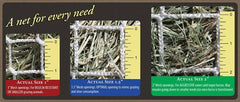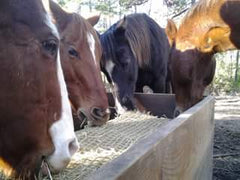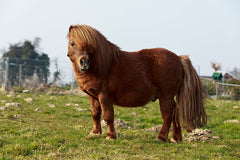FAQs
What should I do if my horse pulls a hole?
We stand behind Freedom Feeder 100%. We know holes can happen and have been helping horses get back to grazing since 2007. We will help you repair the net and our Work With Me Warranty means we'll work with you to transition the horse, even if you have an aggressive feeder who is learning to use the slow feed net.
Please follow this link to our Repair & Warranty page and learn how we can work together to ensure you and your horse are happy customers. https://freedomfeeder.com/pages/repair-and-warranty
My horse destroys hay feeders. Why do you think yours will last where others have failed?
We believe in providing a quality product, and backing that product up with a quality warranty. Many horses that were formerly very destructive have transitioned successfully to our nets. Once they have become accustomed to the nets, they often will ignore loose hay, preferring the grazing-like seeking, sorting and plucking motion used to graze from the nets. We are here to help you transition your horse to slow feeding, with our "Work With Me" Warranty. We are so sure that our nets will stand up to years of use that we offer a Lifetime Guarantee.
What are the different mesh sizes used for?

Our 2" mesh is intended for aggressive, larger muzzled or geriatric horses, as well as for coarse stemmed hay like alfalfa. Our 1.5" mesh is what we have found to be optimal to encourage natural grazing behavior in the average horse fed grass hay. The 1" mesh is for smaller animals like miniature horses, goats, alpaca, and llamas as well as insulin resistant horses who benefit from more restriction.
Can I use different mesh sizes in the same enclosure?
Yes, you can use different mesh sizes in the same enclosure. Just be aware that the animals will likely eat from the larger, easier mesh first and then work their way down to the smaller mesh nets once the easy food is gone.
Why should I use a Freedom Feeder hay net?
Horses are grazing animals, and as such, they should have access to appropriate low calorie, high fiber forage at all times for proper digestion. Regular hay nets don't work well because they have openings that are too large, which are dangerous in addition to encouraging the horses to bolt their food then stand with empty stomachs until the net is refilled. Slow feeding simulates grazing. It slows the horse down, making them search, select and tug each bite as they do on pasture. They chew smaller mouthfuls which gives more opportunity for saliva to mix with the hay. This gives the saliva time to work as nature intended, with enzymes breaking down the forage and allowing more saliva to make it's way to the stomach where it buffers the stomach acid.
While there are many slow feed nets on the market, most are made from a coarse plastic material -- not too different from baling twine -- that has damaged horses teeth and gums. They are also knotted, which is abrasive and gives the destructive horse a point to focus their attention. Most mesh is made on the diamond causing the material to collapse making nets harder to fill, elongating the net for potential hoof hazard, and harder for horses to get hay out of the bottom of the net. Other nets are made from natural materials that don't hold up to nipping and pulling or the enzymatic nature of the animal's saliva, which nature intended to break down plant materials. Hard-body slow feeders made from plastic or metal can inflict injury on the horse's muzzle and have allegedly led to broken and chipped teeth.

Freedom Feeder nets are loom woven from a very soft yet durable knotless nylon that is easy on noses, teeth, and gums. This mesh is square keeping the nets open, easier to fill, nets don't sag, and horses can get all of the hay out. The material was first used in shrimp nets and was designed to withstand tough conditions, harsh temperatures, and yet remain soft and pliable enough to work with. Since 2007, we have only had one report of a horse whose muzzle needed to "toughen up" and that was a foal.
Even the most destructive horses can be transitioned to our nets successfully. Once this happens, our nets last years compared to the months or weeks of useful life typical of other brands. Our "Work With Me" Warranty ensures that we will be there to help you transition your horse. We also offer a Lifetime Guarantee on our nets that extends past the initial transition phase.
What are the nets made from? Does it have chemicals could leach into the hay?
Freedom Feeder nets are loom woven right here in the USA from a soft yet durable knotless nylon that is easy on noses, teeth, and gums. Nylon is a safe, chemically inert material that is used in toothbrushes, medical equipment, and food containers, and because we do not dye our nets, they are naturally UV resistant and there are no chemicals to leach into the hay if the net gets wet.
What type of hay can I use in the Freedom Feeder?
Any type of hay can be fed in our nets. Typically, the larger the leaf blade, the slower it pulls through the mesh. We recommend our 2" mesh for coarse, stemmy hays like alfalfa.
Can I use the Freedom Feeder with a shod horse?

The Freedom Feeder nets can be used with shod horses, but care needs to be taken to either hang the net out of reach of the shoes or (preferably) tie the net into a tub to catch loose hay and keep the hooves away. Please do not use our nets as hay pillows with shod horses!
Will the Freedom Feeder damage my horse's mouth?
No, our nets are made from a very soft, silky material that is easy on skin. As the net ages it will become less silky, but it will remain soft and pliable. If they are laundered regularly, they can remain silky and white for years. Since 2007 we have had only had 1 owner express concern that their horse's muzzle needed to toughen up, and it was a young foal.
Will using a Freedom Feeder hurt my horse's neck or topline?
We encourage you to position your net in a way that is comfortable for your horse, and our Instructions page has a gallery that showcases the different ways our customers have used our nets. Equine dentists and body workers feel providing options for different head positions to encourage flexion and movement is ideal.
Can I use the Freedom Feeder bags to soak hay?
Yes, our nets are fantastic for soaking hay. They are made from a soft marine nylon that was originally used in shrimp nets. The fibers do not absorb water so they don't degrade when wetted, and because they are undyed they cannot leach any chemicals into the hay.
How do I clean my Freedom Feeder net?
These nylon nets are fully washable. Protect your washing machine by removing the clips and any debris from the net, then simply machine was on delicate and hang to dry. Exposure to heat may cause 10-15% shrinkage.
Do I need to re-tighten the Freedom Feeder large round/square bale bags every day?
Not typically. The horses will push and pull the netting around to get every morsel.
How will freedom feeding help my easy keeper?

Having slow-fed, low starch forage available 24/7 is a vital part of keeping the metabolically slow horse healthy. The reduced starch keeps their hormone and insulin levels stabilized, and the ability to "graze" throughout the day keeps them stress-free and mentally healthy. Combined with an environment that encourages movement by having multiple feeding stations, this is a solid foundation for maintaining an ideal weight and avoiding insulin resistance.
How will freedom feeding help my hard keeper?
Having slow fed forage available around the clock increases proper digestion of nutrients, both from the forage itself and in additional supplements. It encourages a healthy gut biome by keeping the good bacteria fed and healthy so that they can extract more nutrients from their feed, keeps hormone levels stable, and reduces stress. Slow feeding also enables the horse to buffer their stomachs with adequate saliva compared to the small amounts of saliva mixed into large bites taken from quick meals. This reduces pain from an empty stomach, eases and prevents the ulcers that hard keepers are prone to. It also reduces stall vices like cribbing, kicking, weaving, food aggression, and windsucking that can be problematic in hard keepers.
Can I throw my net on the ground like a pillow?
Freedom Feeders are extremely versatile. The Extended Day net comes with extra black cords that you can tie together to use as a weaving cord to close the flap. The Trailer/Mini and Day Nets can be drawn closed by pulling the cord from several places and tying them together or tucking the extra cord into the net. The Full Bale net comes with a weaving cord. Any size you choose is very versatile and your installation is only limited by your imagination.
Why do you use those "cheesy" carabiners?
Because we care about your horse's safety. Breakaway carabiners protect your horse from being caught up. There is no locking mechanism where the gate attaches to the clip, allowing the clip to give against pressure.
What are the black cords that come in the extra package?
The extra black cords are spare parts that you can use to make a loop on your stall or fencing to clip the hanging clips to. They are also long enough for you to weave them through the top of the net to make it into a traditional drawstring bag.
How long with my Freedom Feeder last?
It depends on how many horses are using the nets and how aggressive they are but we have had some in use for more than 10 years! On average, there is about a 6-year lifespan, then you can use your Lifetime Warranty to replace your net. If you are asking how long it will take a horse to empty a net, the average horse will consume 2% of its body weight in forage a day. Once a horse has transitioned and is self-regulating, a 1000# horse will consume 20-24# of forage. The Extended Day net should last the average 1000# horse close to a day and a half.
Is it normal for the netting to “fray”?
Yes, it may at first. Sometimes this is because the type of hay in the net has coarse edges. Our material is actually a 288# test 3mm nylon shrimp fishing netting. It is designed to hold up to some pretty harsh environments. The outer weave binds with use and protects the inner structure of the weave. This binding can look “frayed” during the binding process.
Will my horse get enough hay out with the 1.5″ opening?
Keeping the nets full at all times allows the horses to have feed 24/7 similar to what they would have if they were grazing in the pasture. The 1.5″ openings are optimum in that they slow the horses, forcing them to chew their food which makes them salivate. This is important because the saliva has a natural buffering ability, raising the pH and lowering the acid in the stomach so they digest all of their feed better. Larger openings than 2" don't do enough to restrict how fast the forage comes out and are not slow feeders. We are not restricting the amount of hay only controlling how fast they eat it. Did you have an opportunity to watch the video on the opening page of the website? That horse is using a 1.5" net.
Can I wash my Freedom Feeder Small Mesh Hay Nets?
Sure! They’re nylon, so they stand up very well to washing. Take off the strings and clips so nothing gets tangled and toss them in the laundry, or wash them by hand as small hay particles will get into your washer.
How high should I hang the net?
Typically the nets should be hung as low as possible for proper grazing however, we believe in providing options in height not just in the head down grazing position. If your horse has neck, poll or teeth issues, we don't want to force them into any position. You can even use the strings to lace the nets closed across the top then throw them on the ground like a pillow. If your horses are shod you can hang them over a feed bin to prevent them from pawing and possibly getting a shoe stuck. You can also hang the bottom of the net at chest height which is also out of reach from shoes.
Can I use slow feeding for my older horse who is missing teeth?
Absolutely! If your horse is able to chew hay, then they are able to use our nets. We recommend the 2" mesh for geriatric horses because they typically need more forage to maintain weight, but all of the benefits of slow feeding (stomach buffering, psychological enjoyment, stable hormones, etc...) are just as important as with younger horses, if not more so. Keep in mind that as horses age, they do need more than forage to maintain their weight but they still appreciate having the option to graze.
How do I get my horse started with slow feeding free choice hay?
When you first receive the net, maintain your normal feeding routine and add the net full of appropriate forage to the usual routine. Once your horse cleans up their hay ration, they will begin exploring the net. Within a couple of days, when your horse has realized that the net is always full and they are comfortable using it, you can eliminate the loose hay feedings and let them get 100% of their forage from the net.
How often should I refill the bag?
Slow-feeding nets are intended to be kept full 24 hours a day, and that is one of the perks of doing what is best for your horse! Our Day nets hold up to 25 lbs of forage, but most of our customers come back for 2-string Bale/Extended Day and Bale nets so that it is easier to keep forage available at all times. Many of our customers only fill their 3-string bale nets every 5-7 days! The best part of the larger nets is not having to rush home to feed, and being able to sleep in on your days off knowing your horses aren't standing around with painful, empty, acidic stomachs waiting for their breakfast. FREEDOM Feeding is just as much for owners as it is for horses :)
Help! My horse won't stop eating?!
Be patient and try not to panic. It isn't uncommon for a horse to initially consume large amounts of hay, which understandably causes concern for the owners. We have had it take up to 3 months for magic to happen. Just know that once the horse finally feels safe in the knowledge that food is always available, their instincts kick in and they begin to self regulate. Often they begin to maintain weight on less hay than they ate before because their hormones and insulin levels begin to stabilize.
With easy keepers, it is very important that you have an appropriate low-calorie forage to match your horse's digestible energy. Reduce the quantity of supplemental feeds (grains, beet pulp, alfalfa, or complete feeds), not forage or vitamins and minerals if your horse is getting truly fat. Not just a hay belly from the increased digestion. If your horse is obese or Insulin resistant, please contact your veterinarian or equine nutritionist. If you have any concerns, please don't hesitate to contact us. We are happy to help you troubleshoot if you're feeling anxious about your horse.
Can I slow feed my Insulin Resistant/Laminitic/Foundered/PPID horse?
Our nets are perfect for this situation because they help you stretch out your horse's recommended consumption throughout the day. They are also ideal for soaking hay to reduce sugar content because they are made from a soft, marine-grade nylon thread that won't rot, absorb water or leach chemicals and dyes into the hay.
What should I do if my horse gets frustrated?
It's very important to help your horse transition properly to the net to avoid frustration. Start by feeding the horse's normal hay ration as you usually do, and hang a full net of appropriate forage at the same time. Once the horse has finished their usual feeding, they will begin exploring the hay net. If necessary, you can pull strands through the net to help them get started. If you know your horse is easily frustrated, you can start with a larger mesh and then move to a smaller mesh using our Lifetime Warranty. Remember we are here to help, so if you have any concerns, please don't hesitate to contact us!

